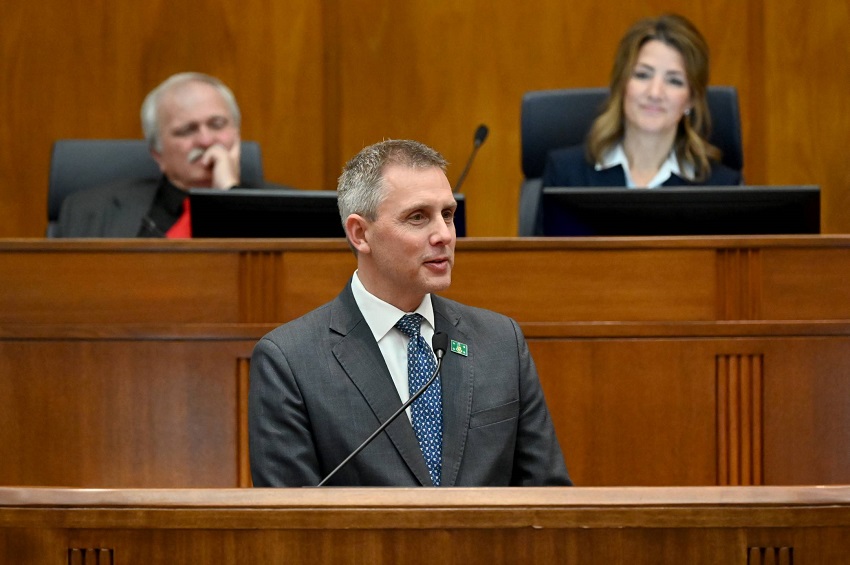Bismarck, ND — Governor Kelly Armstrong of North Dakota delivered his inaugural State of the State Address on Tuesday, outlining a comprehensive property tax relief and reform plan aimed at gradually eliminating property taxes for most primary residences within the next decade. Speaking before a joint session of the 69th Legislative Assembly, Armstrong emphasized the proposal as both a practical and necessary step to provide significant financial relief to residents of the state.
Armstrong began his address by thanking lawmakers for their collaboration in shaping the property tax plan and urged them to prioritize it as the first piece of legislation sent to his desk during the current session.
“We can afford it. The people of North Dakota are demanding it. This plan is real relief and it is real reform,” Armstrong said. “It’s responsible, achievable, and durable. It creates Legacy Fund buy-in. And it is the single most impactful thing we can do for the citizens of North Dakota this session.”
Key Components of the Property Tax Relief Plan
The proposed tax relief plan features two key components aimed at alleviating the burden on homeowners:
- Primary Residence Credit Increase: The current Primary Residence Credit will be raised from $500 to $1,000 per year, a change that will cost the state’s general fund approximately $310 million over the 2025-27 biennium.
- Legacy Fund Earnings Allocation: The plan also proposes utilizing $173 million from the Legacy Fund’s earnings for additional support to the primary residence credit. Initially, this will provide $550 in additional funds per residence, bringing the total relief to $1,550 per year in the 2025-27 biennium. In the 2027-29 biennium, the total relief will increase to at least $2,000 per year.
Property Tax Budget Reform
In addition to providing direct financial relief, the governor’s plan includes measures to limit the growth of local property tax budgets. Future increases will be capped at 3% per year, with unused portions of the increase able to be carried forward for up to five years. Armstrong explained that this provision is designed to encourage local governments, schools, and other public entities to budget more effectively and plan ahead.
Other Key Announcements
Governor Armstrong also touched on several other important issues during his address:
- New Cabinet Position: Armstrong announced the creation of the Commissioner of Recovery and Re-entry, naming Jonathan Holth as the first individual to hold the role. Holth previously served as the managing director of Recovery Reinvented under the administration of former Governor Doug Burgum and First Lady Kathryn Burgum.
- Prison Overcrowding: Armstrong revealed plans to propose a “turnkey solution” to address the state’s prison overcrowding issues, which will be included in his upcoming executive budget address.
- Energy Infrastructure: The governor emphasized the need for further development of pipeline infrastructure to transport natural gas from the Bakken region, which he sees as essential for future growth in oil production.
- Government Streamlining: Armstrong voiced support for legislation aimed at reviewing and potentially consolidating North Dakota’s more than 150 boards and commissions. He further demonstrated his commitment to government efficiency by signing an executive order dissolving five groups that had not convened in over a year.
- Education Initiatives: The governor expressed strong backing for Education Savings Accounts and the establishment of public charter schools. Additionally, he proposed increasing state funding for higher education challenge grants to $50 million, which would support student scholarships matched 2-to-1 by private donations.
- Tribal Relations: Armstrong reiterated his commitment to working closely with North Dakota’s five tribal nations. He stated that the challenges and successes of the tribes are shared by all North Dakotans.
Closing Remarks
In his closing remarks, Armstrong offered a strong message of optimism for the future of North Dakota. “North Dakota is not broken. It does not need fixing. We are home to the best people on Earth. The State of the State is as resilient as its people,” he said. “Our sole focus should be to make their lives easier – to promote policies that make North Dakota the best place to live, work, and raise a family.”
Governor Armstrong’s address marked a significant moment in his tenure, presenting a vision focused on economic growth, fiscal responsibility, and a continued commitment to North Dakota’s communities and families.


